#which is just named 刀
Text
When a dao isn't just a dao 笛飞声的刀不只是刀
A quick and dirty analysis of Di Feisheng's dao
Following up from my previous post speculating about Di Feisheng's dao 刀, I think the configuration of Di Feisheng's dao is quite clever and consistent with his character, despite looking like nonsense at first glance. I know more taiji and kung-fu 刀 dao forms than I do 劍 jian forms, and this is what I choose to do with my knowledge and time, I guess.
Before I launch into his dao in particular, I think it's important that you understand what a dao is, and how you are supposed to attack and defend with one.
When you say 刀 dao (in English, it's also been called a Chinese saber or broadsword), this is what it's supposed to look like (I've annotated the image below from the Wikipedia entry on dao). They are by definition single-edged, and the majority are slightly curved (though there are some variants such as the Nandao 南刀 which are straight). A dao should have a point, a sharp edge (in red), and a blunt edge (in blue). The blunt edge (short edge, or inner edge, since the thing is curved) is usually quite thick.
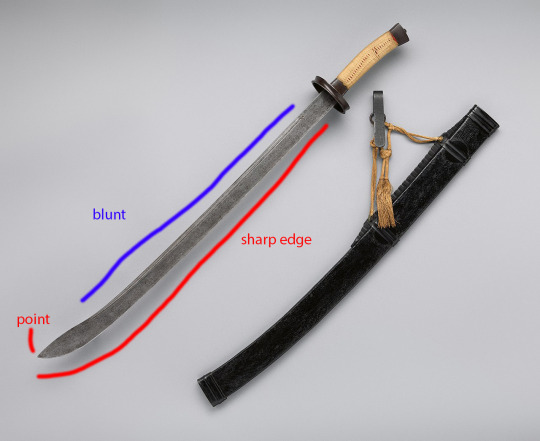
One of the main ways that a dao does damage is through slashing/chopping motions, either down, sideways, or upwards (which my sifu always called uppercuts). All upwards slashes with the dao require that you turn your wrist so that the sharp edge, which usually faces down, faces upward instead.
The other way that a dao does damage is via forward thrusts, where the point of the dao is supposed to pierce enemy flesh. The basic attacks I've mentioned above are in the beginning of this clip, and I've added text to the original video below to highlight what's what and what they're supposed to look like.
(n.b. I was just randomly searching for videos to show what I'm trying to describe, no endorsement intended).
One of the things you'll notice from the above video as well is that the master is putting his hand on the blunt edge. This helps stabilize and give more power to the dao through its various motions, and is a basic part of how dao forms are supposed to work.
The blunt edge is also important because it helps in defense. One of the cardinal rules of a dao is that when you are defending, the dao should be kept close to your body, with the blunt edge facing your body. This is what a basic block looks like:

Should you get hit, you can brace the blunt edge of the blade using a shoulder or upper arm. In certain positions you can also use your hand as a brace on the blunt edge to stop (or execute) a particularly strong attack.
These are the dao basics. Now you have enough background to know what makes Di Feisheng's dao so unusual: it is double-edged, and it has a blunt tip.
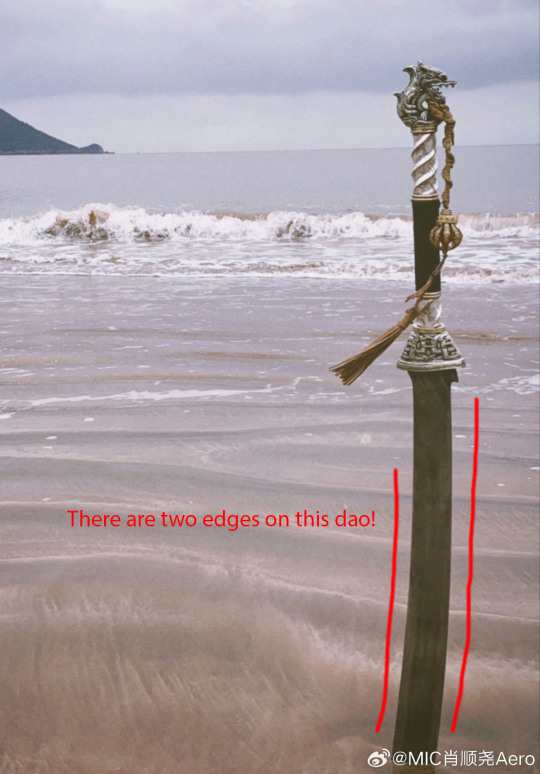
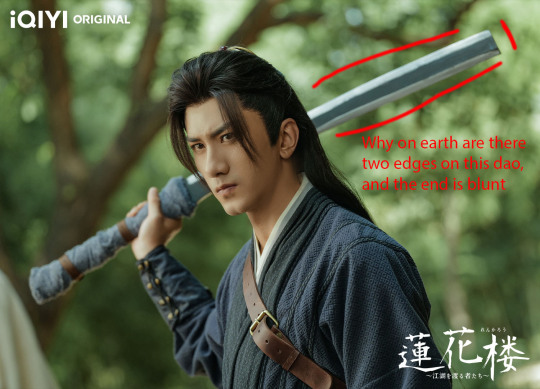
These two things must follow if you have a dao that has two edges and is blunt at the tip:
You are limited to slash and chop attacks as your main blade damage. Thrust attacks won't penetrate flesh unless you have a serious amount of qi behind it.
Your defense is limited, because you can't use your dao to defend in the usual way.
But wait, does Di Feisheng's dao really have two full edges?
If you're a details guy like me, and completely obsessed over Di Feisheng (guilty as charged), you'll notice that one the edges of his dao doesn't actually extend the full length of the blade:
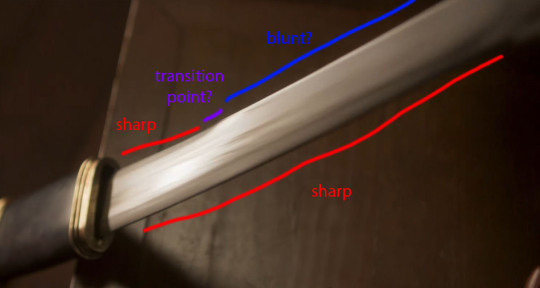
From the way that light reflects off the edges of his dao, you can see a bit on the short (inner) edge of the dao where the blade seems to transition from sharp to blunt:
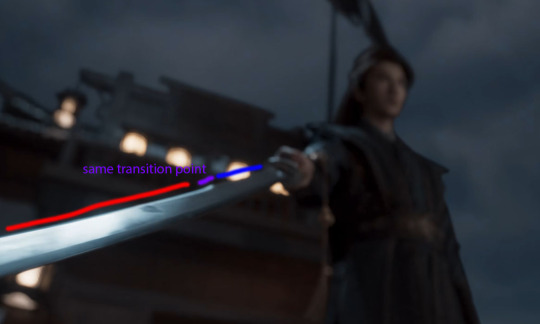
And this shot, it's confirmed that there is a short blunt area on the inner edge of his dao:

In this memorable scene, Di Feisheng uses his hand against the very short blunt part of his dao to press his attack into Li Xiangyi's cheek:
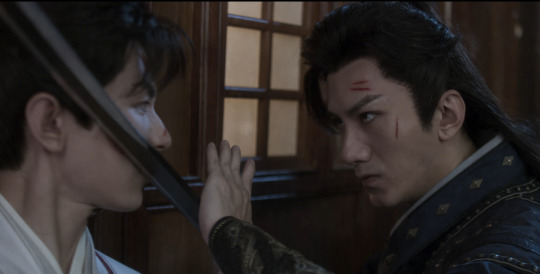
One of the upsides of his unusual dao is also that he can use the inner edge for attacking as well. Upward sweeps using the inner edge aren't possible with usual daos (because they are blunt), but are possible with Di Feisheng's dao. I think we see an example of that here in the way you see his arm sweeping upward. (He has also added a substantial amount of qi to this sweeping strike, most of us plebs don't have enough qi to do anything like this.)

You can see how he gains some flexibility to his attacking capabilities, when he flips his blade mid-block into an attack:

While a double-edge gives him more adaptability in terms of attack on along the slashing and chopping edges of his dao, what he is losing out on because of the blunt end is thrust. You almost never see Di Feisheng thrust his dao forward because his sword just doesn't work like that.
In this final scene in the episode one fight when they are charging at each other, Li Xiangyi thrusts the Shaoshi Jian forward, but Di Feisheng, due to the design of the dao, has to slash:


However, most of the power of a dao is in its slashing and chopping motions. This is where the weight of the blade and its curved design (plus gravity and force) result in the most damage. Unlike the jian, the dao's thrusts do less damage. My conclusion about this is that it's a purposeful trade-off that Di Feisheng has made. He would rather maximize his offensive capabilities where they are strongest.
In terms of blocking, the design of Di Feisheng's dao means he's at a defensive disadvantage, since there's no blunt area to brace his body against for blocking (he can use his hand on the bit that is blunt, but because he has an edge along the rest of it, he can't use a shoulder or upper arm). This is a key feature of the standard dao that Di Feisheng's dao is missing.
In this move in the Battle of the Eastern Sea in episode 1, we see Di Feisheng execute a block, but he's got both of his hands along the hilt instead:

At this point, it should be noted that the standard dao is typically a one-handed weapon. The hilt is slightly curved, so you can get a good downwards chop with your wrist. There are other daos that have straight hilts and can be two-handed like the Miaodao 苗刀 (which is more similar to the Japanese katana 刀 than most Chinese folks like to admit). Di Feisheng's dao being straight-hilted and two-handed isn't that unusual because it's a feature that can be present on certain types of dao (it's way less unusual than the two edges!), but I thought it was worth pointing out in case any eagle-eyed readers noticed the difference between the Wikipedia image and what Di Feisheng has.
I could wax on about Di Feisheng's dao and his fighting style forever, but I think this thread has gone on for long enough.
I believe that the design of Di Feisheng's dao is very clever. At first glance, it seems utterly silly (what kind of dao has two edges?), but on deeper inspection of his style and how he uses it, it is consistent with his character.
He is always playing on Hard Mode because he is trading defense for more flexibility in his offense. And he is maximizing his offense where it is strongest (slashes and chops), and choosing to forego the offensive capabilities where it is weaker (thrusts).
...And that really is Di Feisheng's martial arts style in a nutshell, isn't it?
#mysterious lotus casebook#di feisheng#笛飞声#meta#莲花楼#Di Feisheng's dao#which is just named 刀#刀就是刀要什麼名字#i know more 刀 forms than 劍 forms and this is what i do with the knowledge#笛飛聲#蓮花樓#cdrama#cdrama meta#I'm sorry the GIFs are terrible quality I can't be bothered#also at some point I really want to an analysis of the choreo in the final fight#there was awesome shit being pulled by the choreographers that I've never seen in a wuxia
268 notes
·
View notes
Text
chinese drawing vocab (绘圈常用名词)
for those interested in navigating the online art world in chinese, here's a list of common terms and abbreviations that you might see (translated from zhihu) 🎨
terms
風格 [fēnggé] - art style
人设 [rén shè] - persona
兽设 [shòu shè] - fursona
摸鱼 [mō yú] - doodles, derived from idiom 【浑水摸鱼】 - although the original meaning is "fishing in troubled waters" it's currently used to describe people being lazy/not working hard
劳斯 [láo sī] - homophonic way to say 老师 (teacher) , in addition to 太太,大大,大触, 卡密 -- can be honorific, but 老師 is also just a common way to refer to artists
日绘 [rì huì] - daily drawing
Q版/SD [q bǎn] - chibi (Q = cute, SD = super deformed)
击鼓传画 [jī gǔ chuán huà] - art telephone
绘圈小警察 [huì quān xiǎo jǐngchá] - referring to people who accuse artists of plagiarism/tracing without evidence (direct trans: little art policemen)
抄袭狗 [chāoxí gǒu] - copycat (or dog)/art thief
abbreviations
ACG - animation, comics, and games
CN - cosplayer name
zll (再练练) [zài liàn liàn] - keep practicing
compliments
awsl (阿我死了) [Ā wǒ sǐle] - ah, i'm dead! -- will also see “阿伟死了” (a-wei's dead, a typo), which, after many b站barrages, becomes "阿伟乱葬岗" (a-wei's mass grave)
tql (太强了/太巧了) [tài qiángle/tài qiǎole] - "too strong" (more common usage) or "what a coincidence"
可可 [kěkě] - cute (derived from 可愛)
comments
腿一个 [tuǐ yīgè] - showing your current drawing's progress, directly trans. as "one leg," i.e. showing just the leg -- it's a play on words for 推 (push), i.e. pushing/posting progress
commissions
约稿 [yuē gǎo] - commission/request
接单 [jiē dān] - direct trans. = to accept orders, a less formal way of saying commissions
参考素材/材料 [cānkǎo sùcái/cáiliào] - references
买断 [mǎi duàn] - autobuy for an auction
白菜 [báicài] - high quality, low price art (direct trans: cabbage)
可小刀 [kě xiǎodāo] - haggling prices; 小刀/大刀/自刀 = small/big/self-haggle
出模 [chū mó] - bases/templates
构图 [gòutú] - composition
#chinese#mandarin#chinese language#studyblr#langblr#chinese vocab#tunastudies#chinese langblr#mandarin langblr
110 notes
·
View notes
Text
I have to admit that sometimes I tend to be more of a fan of some of the snappy and cool localized version of words and terms over the clunky or maybe silly sounding literal English version of the words. (that's not to say that i think the japanese words themselves don't sound cool, just that the coolness sometimes gets lost when it's translated too literally)
Terms such as "Master Detective" and "Super Detective"(超探偵), or "Forensic Forte" and "Detective Special Aptitude"(探偵特殊能力). Even when it comes to Super High School Level, I know that it's supposed to sound goofy but I like the term Ultimate, so I kind of internally compromise by imagining that SHSL is for when they're in school and Ultimate is earned upon graduation. That reminds me that the villains in Danganronpa Kirigiri are essentially called
"Crime Victim Relief Committee", but I think I also remember some of the translations call it "The Victims Catharsis Committee", or maybe a succinct "Catharsis" which I think sounds cool and ominous.
And man, Coalescence is just such a cool and elegant english name for Yuma's ability, while it's originally 能力共有(Ability Sharing).
But this preference works both ways because one of the reasons I was thinking about this in the first place is that I so wish that they could've kept the name of Shinigami's sword as 解刀(Kaitou) rather than the solution blade. Even if the amazing wordplay can't be properly translated, Kaitou is just a cool name for a sword.
On a kind of similar note, I wish that they kept the game's original english title as Enigma Archives: Rain Code....
#rain code#raincode#master detective archives: rain code#shiutpost#text#danganronpa#danganronpa kirigiri#drk
47 notes
·
View notes
Text


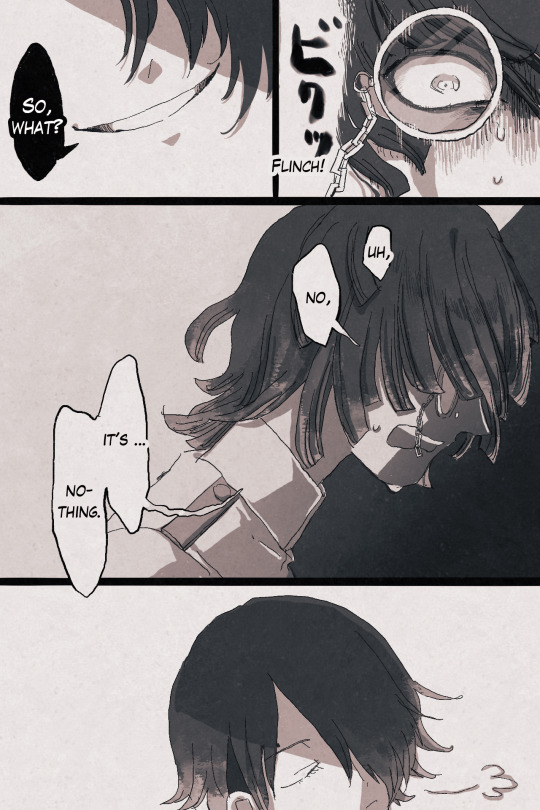




I translated my manga I drew two months ago into English (again).
About Secret dagger:
In Japanese, a right-hand man is called "懐刀".
The word "懐刀" can be read either as "futokorogatana" or "kaito".
懐(futokoro) refers to a pocket where one keeps one's important things.
刀(katana) is the English word for sword,
and "kaito" is the Japanese word for "answer," which has the same sound.
I think the mystery of aide's willingness to kill for Yomi is always there to protect Yomi.*sob*
I wasn't sure how to translate these things, but I ended up with "secret dagger".
That's how I drew this comic, with a lot of thoughts exploding lol.
I personally like the setting that only Yomi knows aide's real face and real name.
I always draw aide with his glasses and cap removed, but that too is just an image, or just a concept.
I think it would be nice to have a setting where aide changes his face periodically or something like that. Or maybe he always sets his face to a face that he likes.
Seth has become a very fluent personality in this manga lol.
35 notes
·
View notes
Text
Chapter 22: Coarse, rough, and gets everywhere
-After dealing with the Yellow Wind demon, the gang ventured forth in this fine autumn season, only to be blocked by the Flowing Sand River, 800 li wide and full of Weak Water.
"What, exactly, is a Weak Water? Are there like, Strong Water?"
-As the poem suggested, Weak Water(弱水) refers to water that has no buoyancy, and anything that fall in would just sink, even a feather. Record of such strange water appeared first in the Book of Mountain and Sea; it surrounds Mt. Kunlun, the abode of Queen Mother of the West, and Book of Late Han also stated that Weak Water and quicksand could be found near QMoW's dwelling.
-These tales could be inspired by IRL geography, where a lot of the rivers in western China, bc they are flowing through plateaus or deserts, are very shallow in depth and regular boats would just capsize inside. When non-native ppl saw those rivers that couldn't be traversed by boats, they thought the water itself has no buoyancy.

-Also, there was a portion of Gobi Desert the historical Xuanzang crossed, 莫贺延碛, which had the alternate name "Sand River"; in Xuanzang's biography, this was also where he was awoken from his thirst-addled sleep by an unnamed great deity. Much like how this desert deity would later evolve into Sandy, the "Sand River" would also become a literal river in the JTTW story cycle.
-We learn the real reason SWK isn't good at underwater combat: he either needs to use one hand to cast a Water-repelling Spell in order to move freely, or transforms into an aquatic critter, both of which would get in the way of wielding his staff.
-Hmmm, why couldn't he just grow a third arm (sth he's obviously capable of, given his fight with Nezha) and use it to maintain the spell while bashing some aquatic demons' head in? Maybe only 1 concentration spell is allowed at a time, D&D style...
-I feel like we've all wondered what the job of "Curtain-raising General" entails—is he like, literally the guy at the gate who lifted those fancy bead-curtains every time a celestial came through? Well, kinda. Not really.
-"Curtain-raising" is actually an important part of Daoist rituals. Before the sacrificial offerings began, there were curtains covering statues on the altars, and only after it was believed that the gods in question had arrived to court were the curtains lifted(literally or metaphorically), and the priests able to present their prayers to them.
-Here is a video of the "Curtain-raising Charm", performed by Quanzhen Daoists:
youtube
-So Sandy's job is less gate guard, and more of an announcer of JE's court sessions. This is my personal take, but I feel like part of why the punishment for him breaking a cup was so harsh was bc he was an official specialized in court rituals and propriety, so he should've known better than to jeopardize such an important event.
-We also learn the answer to another question many have asked: "Why can't SWK just fly Tripitaka to Vulture Peak on his somersault cloud?" Turns out, a mortal's body was too heavy to be carried on clouds, and though the Yu translation was slightly wonky here, ordinary demons could summon a magical wind for fast-travel and kidnapping, but they were still staying close to the ground and not truly high-up in the air.
(Also, if he could, we wouldn't have a 100 chapter story.)
-Finally, some internal alchemy stuff relating to Sandy from my annotated Chinese edition: during the fight between Pigsy and Sandy, the latter was referred to as the Spatula, 刀圭. The second character, made of 2 characters for "Earth" stacked on top of each other, was later broken into "Two-Earths" in referral to Sandy again.
-In internal alchemy, Earth represents ideation/determination, specifically, that of attaining immortality. When the ideation stills, it is known as "Yin-Earth", and when it stirs, the "Yang-Earth", collectively referred to as "Two-Earths". It functions as the catalyst and meditator between the Spiritual Mind(Wood) and Vital Energy(Metal), which must come together and mingle during cultivation to form the Golden Elixir.
-Thus, Sandy's soon-to-be role as the Only Sane Man and meditator between SWK and Pigsy.
@journeythroughjourneytothewest
18 notes
·
View notes
Note
It would appear I have been summoned again lol. I am currently trying to talk with Japanese players about Sephiroth’s voice lines in EC and I really can’t recommend looking into the discussions on the LifeStream website enough—especially if you guys are curious about this stuff.
For instance, here are the names and Japanese names of Seph’s weapons and attacks so far!
Localization notes:
Limit Breaks
Astral Gate (星門, Seimon, lit. "Planet's Gate" or "Star's Gate")
Ardent Flare (アーデントフレア, Ādento Furea)
Weapons and Abilities
Nameless (無銘, Mumei)
Telluric Fury (動地, Dōchi, lit. "Shaking Land")
Edged Wings (斬り羽, Kiriha, lit. "Cutting Feather," a euphemism for an excavation site)
Aerial Frostblade (氷翼急翔, Hyōyoku Kyūshō, lit. "Cold Wings Swiftly Soar")
Glaireid (グライレイド, Guraireido, lit. "Gli-Raid," Glide+Raid)
Sweeping Slash (孤斬, Kozan, lit. "Lone Cut")
Aonibi (青鈍, Aonibi, lit. "Dull Blue")
Frenzied Stance (荒天のかまえ, Kōten no Kamae, lit. "Stormy Weather Stance")
Northern Lights (ノーザンライツ, Nōzan Raitsu)
Radiant Aurora (極光, Kyokkō, lit. "Aurora")
Prototype Crimson Blade (試作・紅蓮太刀, Shisaku: Guren-tachi, lit. "Prototype: Crimson Tachi")
Firaga A
CC Alloy Sword (CC合金刀, Shi-Shi Gokin Katana, lit. "CC Alloy Katana")
Thundaga A
Mythril Type-0 Katana (ミスリル0式打ち刀, Misuriru Reishiki Uchigatana, lit. "Mythril Type-0 Uchigatana")
Steadfast Stance (不動のかまえ, Fudō no Kamae, lit. "Immovable Stance")
Shinra Blade: Model I (神羅刀壱号, Shinra Katana Ichigo, lit. "Shinra Katana No. 1")
Shock Blast (ショックブラスト, Shokku Burasuto)
Gear
Shinra's Hero (神羅の英雄, Shinra no Eiyū) - Default; pairs with Nameless
Edged Wings Training Garb (羽刃の修験装, Kiriha no Shugensō, lit. "Cutting Feather Ascetic Garb") - Featured; pairs with Edged Wings
Aeroglider (グライディングスーツ, Guraidingu Sūtsu, lit. "Gliding Suit") - Voucher; pairs with Glaireid
—
Some curious details include: Sephiroth’s training garb’s name, “cutting feather,” is apparently a euphemism for an excavation site, and though not mentioned here, that Japanese name “kiriha” is the name of a famous sword, kiriha sadamune. This sword was forged by one of the sons of Masamune. A cool detail.
I find it interesting that Sephiroth’s default set could be run together as “Shinra’s Nameless Hero” too.
Sephiroth’s training garb also seems to be a very strict get-up if we go by Japanese. It is his “ascetic garb” which has the implications of something you wear to practice strict self-denial and discipline, almost like a monk.
People have been discussing some other great details on the LifeStream forums since the new Ever Crisis chapter—especially about Seph’s Nibelheim meltdown being his literal “Limit Break” as a person, and why that changed the name of that very attack to “Hell’s Gate” after it summoned the fires of Sephiroth’s wrath.
People also noticed how much Jenova in Advent Children’s opening looked absurdly close to the picture of Lucrecia AND Sephiroth in general. Ever Crisis is really giving us a ton of insight. I will keep sharing with you guys the more I talk to the Japanese players and my friends. I am just a lurker here but I feel like certain great tidbits of info are being missed, so I will do my best to share. I will also try to get those voice line translations!!
You're amazing. Thanks so much for all your valuable insight! I personally find this stuff pretty fascinating.
#asks#ff7#ffvii#final fantasy 7#sephcanons#sephiroth#Ffvii first soldier#first soldier#ffvii ever crisis#ffviiec#ff7ec#ff7 ever crisis#ever crisis#Thanks so much to our incredible translator anon!
39 notes
·
View notes
Photo


Wu Ming 无名 (Nameless) Lyrics
Watch the performance here.
Please credit if you would like to use this translation.
Translation notes below the cut ↴
This song really sets the tone so well for the movie and I couldn’t help but get excited and share. Here’s further explanation of the lyrics, which are written by the movie’s director, Cheng Er:
你没有名字
You who have no name
你衣冠楚楚
You who are so well-dressed
你笃定无言
You who remain so calm and reticent
你属于夜晚
You who belong to the night
"You who are so well-dressed” refers to Yibo’s character, Secretary Ye. Up until now, we still don’t know what his full character name is. In Cheng Er’s side story that he wrote, Secretary Ye is described as “衣冠楚楚” (well-dressed), and in presscon interviews this is also the phrase used to describe him. This is something that he is at first admired for by his fiancée's mother, then later detested for by his fiancée in the story. He is described as a man of few words.
纸醉金迷的喧闹孤岛
An isolated island so lavishly gilded and full of noise
纸醉金迷 is an idiom, which translates literally to “being drunk and intoxicated on gold and paper (money)” and is used to describe indulgence in luxury. (source)
孤岛 can be translated to lonely or isolated island. Given the context of the movie, which is set in Shanghai around the time of the Japanese occupation (1937-1945), here 孤岛 can also refer to the “isolated island” era of Shanghai. In 1937, Shanghai fell to Japan and the Japanese occupation began. However, parts of the Shanghai International Settlement (American-British joint settlement) and the French Concession neighbourhoods remained free from Japanese occupation, as Japan did not want to directly confront these nations here. Many citizens fled to this area, which was otherwise surrounded by the Japanese. Thus this area became known as the “isolated island”. Here, wealth overflowed, as many of the rich took refuge here. (source)
刀光剑影的无声往昔
With its silent history of flashing blades
刀光剑影 is another idiom, it translates roughly to “flash of knives and shadows of swords”, and it is used to describe a dangerous atmosphere. Again, this makes sense in the setting of the Second Sino-Japanese War. (source)
觊觎者来来往往
The coveters who come and go
I’ve translated 觊觎者 as coveters, it describes people who covet or yearn to have something that is not theirs, whether it be money or power or people.
I’ve decided to translate the title 无名 as “nameless”. Here in the song, as well as in the movie, it is used to describe the underground spies that worked during that era (which may include Secretary Ye himself - this is not confirmed and is just something that has been speculated).
This is simply my interpretation of the lyrics. I always enjoy reading different translations and would love to hear others’ thoughts. The song has certainly inspired more excitement for the movie for me, I hope it may inspire the same for others!
#wu ming#wang yibo#hidden blade#wuming#cheng er#tony leung#translations#I got too excited and wrote too much#I'll continue to edit this as we get more contextual information
121 notes
·
View notes
Text
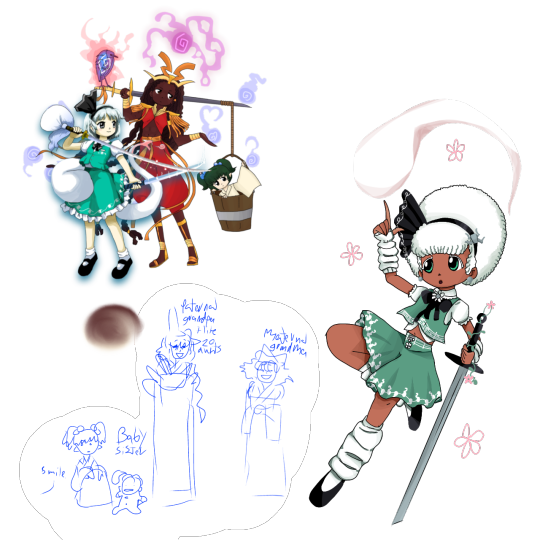
Just playing with a funny idea of my samurai and gensokyos samurai having a kid, which in turn would make Afro youmu real lol.
Thinking of a name I came with 魂朝刀山 (read Kontomo Tatayama) it would litterally mean something along the lines of ghost morning sword mountain. Last name is just the first kanji of Konpaku and the Last of Yoritomo. Tatayama comes from the whole sword thing and Jabalis name meaning mountain or cliff in Swahili. I also like how Tatayama sounds cause it sounds like Tatiana
In no way canon to my story of touhou of course, just an idea I found really fun to play with.
#touhou#touhou project#touhou fanart#touhou oc#perfect cherry blossom#jabali yoritomo#youmu konpaku#afroumusweep#I’m not sure who first made the black Youmu design but credit to them!#touhou kisume#chiharuo yoritomo#yuyuko saigyouji
24 notes
·
View notes
Text
BNHA Observations, speculations and assorted info: Todoroki Mansion (Part 3: Training Hall)
So, in order to write my fic, I spend much time observing canon scenes, comparing the manga and the anime version, take note of details, translations and info in them as well as finding out how are some things called.
Since what I noticed/speculated/found out can be of use for other fic authors I thought to share as well.
Resources:
Chap. 39 “Todoroki Shōto: Origin” (轟焦凍:オリジン Todoroki Shōto: Origin)
Chap. 95 “End of the Beginning, Beginning of the End” (始まりの終わり 終わりの始まり Hajimari no Owari Owari no Hajimari)
Chap. 202 “Match 3” (第3セット Daisan Set)
Chap. 290 “Dabi's Dance” (ダビダンス Dabi Dance)
Chap. 291 “Thanks For Going Strong” (元気でいてくれてありがとう Genkide Ite Kurete Arigatō)
Chap. 359 “Bound to a Fiery Fate” (エン En)*
Ep. 23 “Todoroki Shōto: Origin” (轟 焦凍:オリジン Todoroki Shōto: Origin)
Ep. 50 “End of the Beginning, Beginning of the End” ( 始まりの終わり 終わりの始まり Hajimari no Owari Owari no Hajimari)
Ep. 95 “Match 3” (第3試合 Daisan Shiai)
Ep. 124 “Dabi's Dance” (ダビダンス Dabi Dance)
OAV “Save! Rescue Training” (救え!救助訓練! Sukue! Kyūjo Kunren!)
-* In Japanese the title is written in Katakana, making impossible to figure out to which Kanji it refers. The reading for 'en' belongs to the kanji that can be translated as "flame/fire" (the first kanji in Enji's name) but also to the one that can be translated as "fate/destiny", "bond/connection/family ties" and "hatred". The English translation tried to put all those meaning together into a single sentence.
OBSERVATIONS, SPECULATIONS AND ASSORTED INFO:
The "Training hall" (訓練場 ‘Kunrenjō’) is that place in the Todoroki mansion where Enji trains himself and his children (Touya and Shouto).
Actually, although the Enligh version calls it "training hall" the 'jō' (場) part can mean "place", "spot" but also "arena", "stadium".
HOW ONE REACHES IT?
From the Genkan, taking the corridor on the right and walk through it till then end...

...turn on the left and keep walking through what should be the engawa...

...then turn on the left again and continue until you reach this building.

...and get through the Shōji door with lower door panel above which there's the sign 'training hall'.
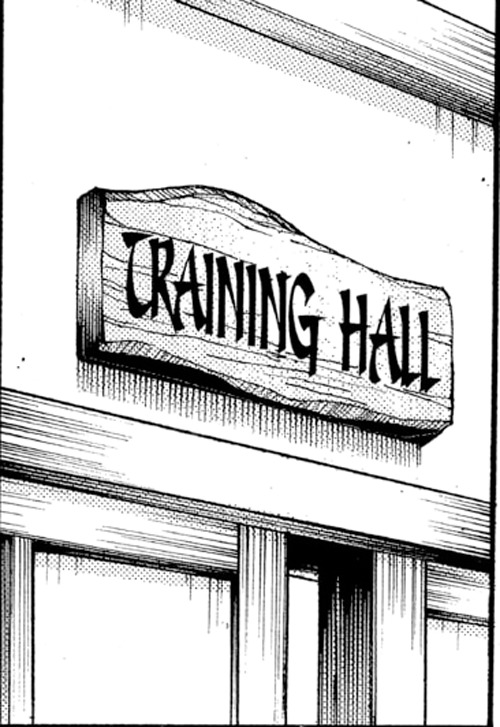

In case you don'r know, Shōji (障子) are doors, windows or room dividers used in traditional Japanese architecture, consisting of translucent (or transparent) sheets on a lattice frame.
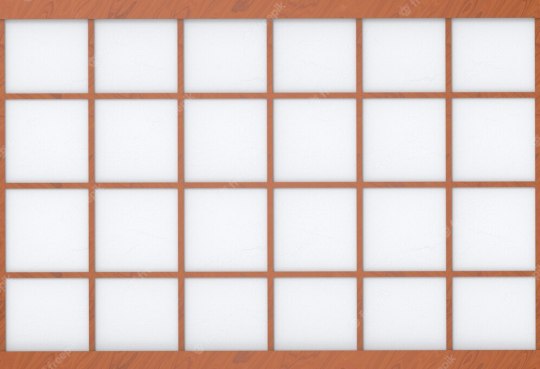
In the anime just take the corridor on the right...
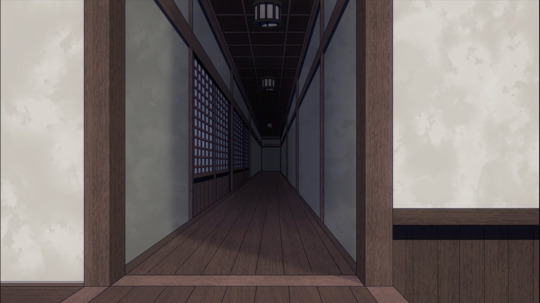
...and keep walking until you reach a Mairado door...
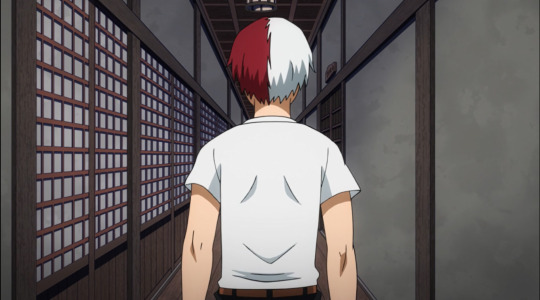
...above which there's the sign 'training hall'
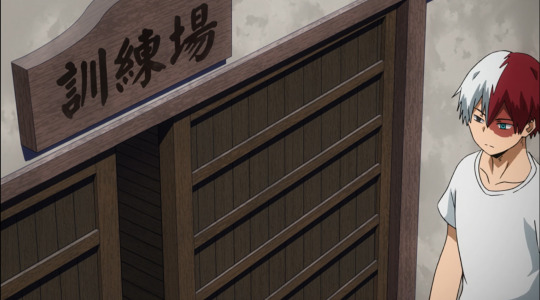
By the way, Mairado (舞良戸) are a wooden sliding door constructed of a single wooden panel, the Wataita (綿板), and set into a timber frame, the Kamachi (框). It is characterized by the addition of thin parallel crosspieces, the Mairako (舞良子) set horizontally on both sides of the panel.

HOW DOES IT LOOK INSIDE?
In the manga it's usually a bare, large room (only once it's shown to have inside training equipment) with a Shōji door with a lower door panel to get in and a Shōji window on the right, a wooden floor...

... and a Saobuchi tenjō (竿縁天井 "rod edge ceiling") ceiling, a flat wood ceiling supported by narrow wood beams.

In the anime (and in the OAV) also have a moment in which they show it filled with training equipment...
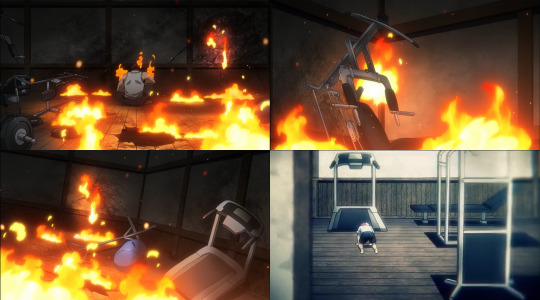
...while in other episodes it seems to be empty.
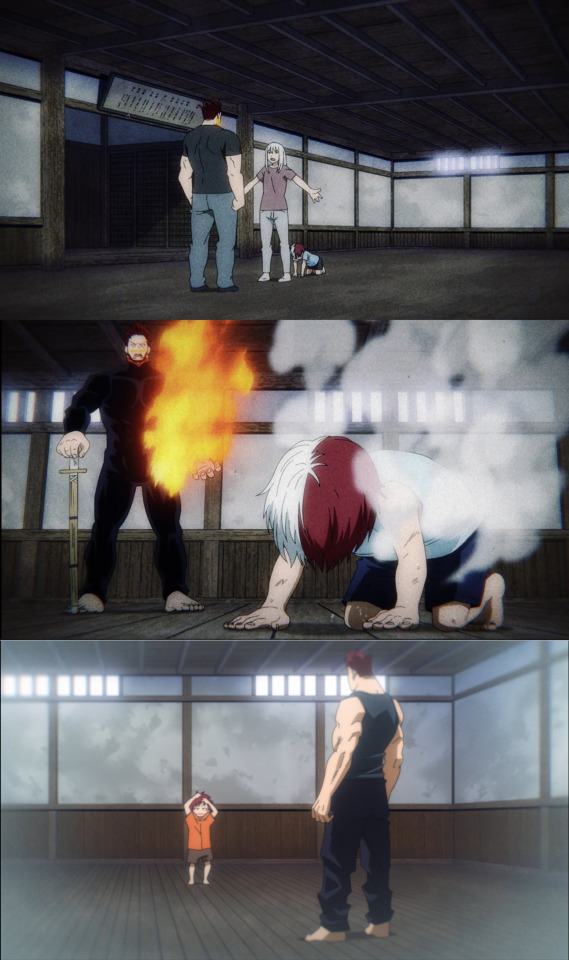
The anime add an extra space in it, which seems empty if not for a Mairado door and with a sign above it with some writing that can't be deciphred.
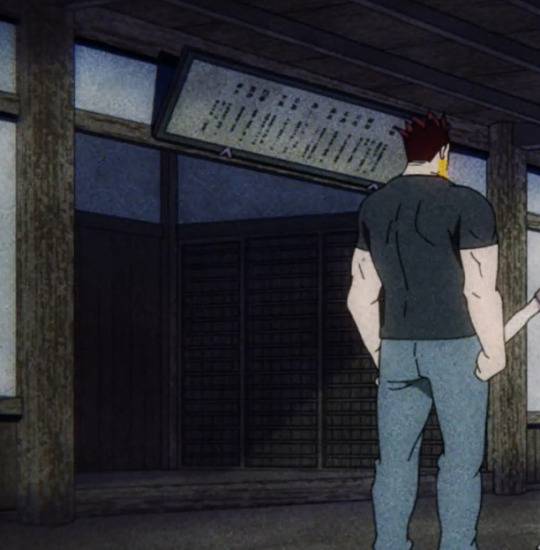
On the sides of the Maraido door that leads in one can see Shinai and Bokken.

BTW Shinai are the swords used to practice Kendō (剣道)...

...while Bokken (木剣 "wood sword"), also called Bokutō (木刀) are Japanese wooden swords used for training in kenjutsu which are usually the size and shape of a katana.
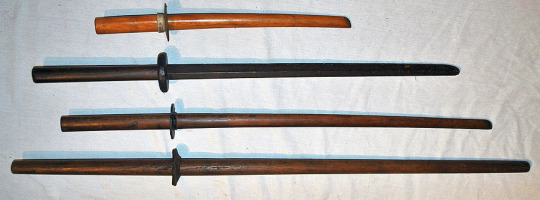
By the way, I said the anime gives to the room a Maraido door... though in one episode the door seems to be a Shōji one (the visual is poor though so I might be mistaken)...
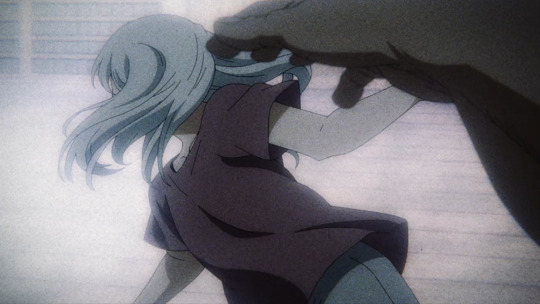
and in the OAV it seems to be a Fusuma one...

So yeah, the anime isn't really sure how the room is structured either.
As if to make matters weirder, the anime also gives Enji a small room that's filled with training equipment along with a tv and tatami floor instead that wooden floor like the training hall...

BTW Tatami (畳) is a type of mat used as a flooring material in traditional Japanese-style rooms.
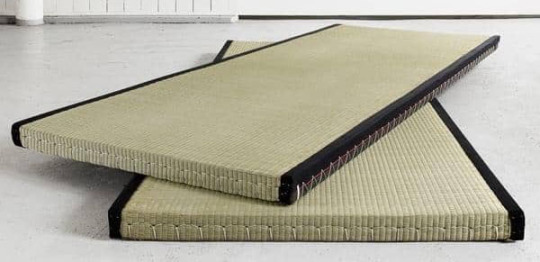
In the manga we can't see what's inside this room beyond the fact it has a TV...

...all that's visible is the Fusuma door... so of course the anime felt obliged to instead give it a Shōji one.
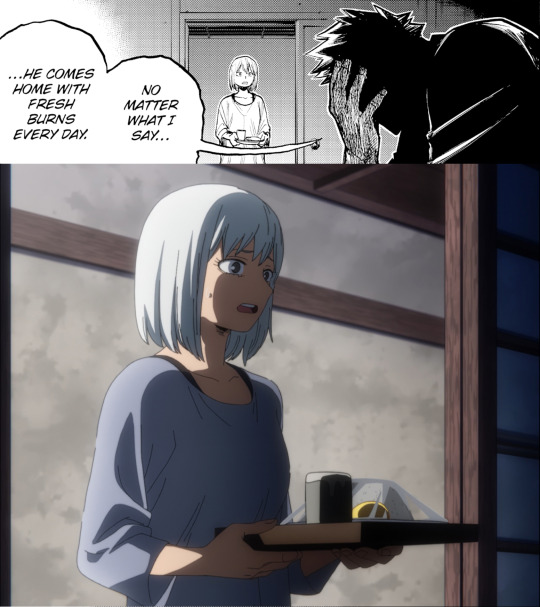
In the manga the fact the room has a Fusuma door makes impossible for this room to be the dining room (even if Rei is bringing Enji food). In the manga the room is probably meant to be the tv room (in it there's a Fusuma door as well as the tv).
Why the anime felt the need to change things and turn this into a different room is beyond me.
#boku no hero academia#Todoroki Enji#Todoroki Shouto#Todoroki Touya#Todoroki Rei#Todoroki Fuyumi#Todoroki Natsuo#bnha observations
8 notes
·
View notes
Text
LoZ - Sheikah Arts
Kokoro no Me (心の目, Mind's Eye) is a state that allows those who open it to see the truth. Which includes seeing past illusions as well as granting the ability to see past invisibility & enable them to see & interact with spirits, whether dead or otherwise. Some rare few are also gifted with other talents ranging from limited future/past sight or heightened perception not unlike what one sees from Apollo Justice in the Ace Attorney series.
As one trains their Kokoro no Me, their eyes will begin to slowly encrimson over time before turning a bright, ruby red.
This is a canonical technique, though I've added a couple of things onto the concept.
It takes years of hardwork, dedication, & asetic meditation to achieve it & is considered the birthright of the Sheikah, having originally been taught by their creator deity, whose name has since been lost to time.
The specific way that the Mind's Eye is trained is via a type of asetic training that combines the IRL concepts of Kiko (basically Qigong), Tummo, Aiki-Jūjutsu, yoga, activating the Chakrahs, & just overall spiritual growth & maturation.
I think that it'd also give the power to Scry & possibly even something like Eyes of the Night & Hunter's Mark from DnD. However, Scrying & Hunter's Mark would be the sort of things that a Sheikah would need to train specifically.
For more on the specifics of the Mind's Eye & how it's opened, go here.
---
Tōhi-Jutsu (逃避術, Escape Technique) is an essential art to know for any Sheikah warrior. For all intents & purposes, it's the art of escapology.
However, it's a mostly physical art & doesn't really work on magical bindings or sealing. One could feasibly learn a way to get passed such things, but it would require study into whatever magical binding was used, which would, at the very least, require knowledge of the inner workings of basic magical theory & sealing techniques.
---
Another extremely important skill for a Sheikah to learn is Kankyō Undō no Geijutsu (環境運動の芸術, Art of Environmental Movement; this is a name that I made up), which is an athletic discipline that allows practitioners to traverse just about any environment in the most efficient way possible using their physical abilities. This commonly involves climbing, running, jumping, vaulting, rolling, & other such movements. This is basically parkour, freerunning, & efficient climbing all rolled into one neat little package.
One part of this is Ukemi (受け身, lit. translation, recieving with/through the body), or the art of falling, which allows you to know instinctively how to fall in a way that causes as little damage as possible.
It'd also come with training to be able to use magic to enhance certain capabilities in a way not dissimilar to Step of the Wind, Slow Fall, & Unarmored Movement.
—
The Sheikah art of forging blades is known as Hachi Shita-Kitae (八下鍛え, Eight-Folding Technique) & their techniques have been passed down over several thousands of generations. In the art of bladesmithing, they are especially illustrious.
The technique involves the repeated folding & hammering of the metal to evenly distribute impurities throughout the blade, increasing its hardness & durability. The reason being that the Sheikah live in an area where the iron quality is very poor. So, they use this technique to get around it.
And while, yes, Goron iron is more high quality & more durable, it also tends to be more brittle & very inflexible. Neither are very ideal for bladesmithing as you want your blade to be able to bend a bit, but not just effing shatter entirely. A blade that bends, will typically snap instead of shatter & snapping is much easier to repair than outright shattering. As such, their own iron is still better for forging blades. The Sheikah do use Goron iron for making tools & weapons that don't really need to bend, though. Especially forging hammers, Jōhyō (chained kunai or rope dart), & Kunai.
Anyway, this technique is used to forge what are known as Kakaritō (カカリ刀). Which is just the overarching category that Sheikah blades fall under.
There have since been new developments in the Sheikah's forging style by a Masamuna family prodigy. The Masamuna family being the oldest & most skilled known Sheikah forging family. Their smithy is located in Rikoka Hills, north of Kakariko. (Inspired by the Second Wind mod for Breath of the Wild.)
One such advancement being Kaijū-Hone Yakin (怪獣骨冶金, Monster Bone Metallurgy), which is the method of melting monster parts down & working them into liquid metal. You don't necessarily need to use only bones & only use them on blades to actually be practicing this. You could weave a whip from the leather of a Lizalfos' tail &, while not Yakin specifically, it still counts as Kaijū-Hone.
Toketa Hōseki Shita-Kitae (溶けた宝石下鍛え, Molten Gem-Folding Technique) is the art of liquifying gemstones & folding them into metal to create a blade in order to impart their ingrained, elemental magic upon the weapon. The Hōseki Shita-Kitae actually being a sort of evolution of the Hachi Shita-Kitae as the folding process is essential to integrating the gemstones' magic into the weapon.
For more on the specifics of Sheikah Weapon Smithing & what sorts of weapons they make, go here.
—
Karada Yomijutsu (体読み術, Body Reading Technique) is basically Hellstromism or contact mind-reading. In other words, it is the art of talking & observing someone's facial ticks, body language, & muscle movements to discern their thoughts via their body's instinctive reactions to what is being said or what they're looking at.
For an idea of how this looks, at least in media, I'd recommend watching Now You See Me 1 & 2. While the concept is very sensationalized there, it still gives a decent idea of the idea behind it.
—
Sheikah cuisine tends to focus quite a lot on flavor pairings similarly to South Korean cuisine.
They call it Oishī Shinajīdō (美味しいシナジー道) or the art of delicious synergy. This isn't a thing they do just because; it's both a science & an art form.
Any Itamae (板前) worth their salt studies it. Itamae being a type of skilled master chef.
They also have a branch known as Eiyō Bishokugaku (栄養美食学) or Nutritional Gastronomy. Which is the optimization of food through the use of certain ingredients to strengthen the body in different ways.
It's basically a more scientific version of how the games use food effects.
Though, neither Eiyō nor it's sister concept of Bunka Bishoku (文化美食) are studied as ardently or as widely as Oishī Shinajīdō.
Bunka Bishoku being Cultural Gastronomy, which is the study of the cultural & history behind foods & ingredients.
---
There is also Kiridō (斬道, Cutting Art), the art of the knife. Which is broken down into 2 branches: Kirijutsu & Santoku. Which are 2 different types of knife styles.
Kirijutsu (斬術, Cutting Method) specifically being the martial or self-defensive use of knives, such as Kunai or Kodachi, & is easily adapted to the use of sickles. Meanwhile Santoku refers specifically to the use of the knife in the kitchen.
Santoku (三徳, Three Virtues or Uses) refers to the 3 uses for kitchen knives: slicing, dicing, & mincing.
While one can learn Santoku separately from Kirijutsu if they so desire, it is thought in Sheikah culture that in order to get the full understanding of all that a Hōchō (包丁, Kitchen Knife) is capable of, one must also know how to defend oneself with that Hōchō. Which, while Sheikah-made Hōchō are not designed with the thought of fighting specifically in mind, they are designed to be able to be used in such a way & be effective at it, if necessary. This is due to it being said in Sheikah culture that the best knifefighters know how to use a Kiri to cook just as easily as to fight & vice versa.
As a result, the best Sheikah chefs are also skilled in knifefighting.
Hōchō come in a variety of styles.
Including, but not limited to Gyuto-Bōchō (Beef or Chef's Knife), Yanagiba-Bōchō (Sashimi or Sushi Knife) & Kiritsuke-Bōchō (Executive Chef Sashimi Knife), Santoku-Bōchō (3 Virtues or Multipurpose Knife), Sujihiki-Bōchō (Slicer, Carving, or Meat Knife), Nami-Bōchō (Bread or Cake Knife), Kikusumi-Bōchō (Petty, Utility, or Fine-Detail Paring/Peeling Knife), Honekotsu-Bōchō (Boning Knife), Usuba-Bōchō (Vegetable Knife) & Nakiri-Bōchō (Home-use Vegetable Knife), & Chuka-Bōchō (Cleaver).
While each design has its uses, the Gyuto-Bōchō is considered the most versatile as it is able to dice veggies, slice meat, smash garlic, & chop herbs & nuts. It is most often used to prepare non-Sheikah dishes & can often replace most any non-Sheikah kitchen knife.
The Santoku-Bōchō is likewise very useful as it is used for the 3 virtues of kitchen knives: slicing, dicing, & mincing. It is perfect for slicing, dicing, & mincing fruit, vegetables, fish, & boneless meat. It is thought to be able to accomplish just about anything a non-Sheikah kitchen knife can & is considered a multipurpose Home Chef knife.
Honekotsu-Bōchō is an all-around meat, fish, & boning knife that can be used for anything from delicate filleting & detailed boning, to larger cuts of meat, & even heavy boning depending on the sharpness. It can specifically be unsharpened for heavy work or sharpened for fine detail work. (In terms of meta-narrative, Honekotsu-Bōchō are sort of a fusion between the real world Honesuki-Bōchō & Hankotsu-Bōchō.)
Anyway, when knives are worn down or become broken, they are not merely disposed of as, much like any tool & especially swords, the Sheikah believe that over the years of use that knives develop spirits known as Tsukumogami or tool spirits/gods. When this happens, it's thought that the knife becomes a very personal part of the chef & an extension of themselves, also similar to swords.
And as such, just like with swords, knives are often given burial places, or Hōchō-Zuka (包丁塚, Kitchen Knife Mound).
These Hōchō-Zuka monuments are often used to pray for improved knife & cooking skills.
It is partially due to this reverence that the Sheikah are well-known for having the least wasteful kitchens in Hyrule. As they have a culture of diligent tool maintenance. Meaning resharpening blades, replacing handles, & reviving knives & swords many times over.
As a result, Sheikah blades, both knives & swords, tend to last for literal lifetimes.
(Much of this is based on actual Japanese concepts.)
Anyway, a knife block was a Hōchō-Kaku (包丁角, Kitchen Knife Square), but the knife set itself, especially if it was fully stocked with everything a chef needs, was referred to as a Kamado Nakama (かまど仲間, Oven Companion) as the Sheikah refer to their kitchens as Kamado.
Hōchō-Kaku & Kamado Nakama generally come in 2 types: Katei-Yō (家庭用, Home) & Mamena (まめな, Diligent). As you can likely guess, one is for home-use & one is for professional-use.
Interestingly enough, it is a tradition for a woman's first Hōchō-Kaku to be gifted to her by her husband for their first house together. Generally, those tend to be Katei-Yō unless the man is either marrying a chef or is a chef himself.
---
The Sheikah have several branches of cooking specialty. To become a master of that branch is to become an Itamae (板前) or skilled master chef.
Just a few of the different types of Itamae are Sushi Itamae (寿司板前) or skilled sushi chef, a Yaki-Itamae (焼板前) or skilled grill chef or pitmaster, a Doku-Itamae (毒板前) or a type of skilled master chef who specializes in the preparation of normally poisonous or venomous ingredients before cooking & serving them. There are, of course, other types as well.
Though, even the simple Katei-Ryōrijin (家庭料理人) or homecook is still given a degree of regard.
In fact, Katei-Ryōrijin (家庭料理人) were the ones who developed a method of turning the meat from very old or sick animals tender by periodically transferring meat from the grill to ice or snow or even Ice Fruit & back again, repeatedly. This process causes the meat to shrink & expand, becoming very tender. Melt-in-your mouth tender. It also prevents the meat from ever being overcooked.
It is referred to as Yukinoyono Niku (雪の夜の肉) or loosely "Meat Eaten on a Snowy Night." The technique is now used by Yaki-Itamae because of how deliciously tender it makes the meat.
(This technique is inspired by the Korean Bulgogi method, Seol-ya-myuk, which means the same thing.)
These simple homecooks are thus considered to be natural innovators within the world of food & despite not being classified as official Itamae, are often called Tenpu Ryōrijin (天賦料理人), or natural-gift cooks, bordering on Subarashi Ryōrijin (素晴らしい料理人) or great/wonderful cooks, depending on the situation & the talent of the individual.
---
The Sheikah stealth training is known as Kakusu Tanren (隠す鍛練, Hiding Martial Training) & one way they train this is by wearing Pokkuri Geta, which are sandals with hollow bases that have little bells inside. This causes the bells to jingle while they walk.
However, much like in Dragon Ball where Goku trains with Popo, there is a way to move without disturbing the bells. Which is exactly the goal. Sheikah Warriors will often keep their old Pokkuri Geta as mementos of their training days at the Kasuto Bieldcamp. (The hidden village in TP.)
This technique is called Neko no Sanpo (猫の散歩, Cat Walk) & is part of how the Sheikah learn to become so stealthy.
In real life, Pokkuri Geta are worn by Miko.
---
Tekishutsu (摘出) is also a very useful skill. That being lock-picking. Though, not many actively practice it anymore in the modern era.
---
Sadō Shugi (茶道主義) or teaism is the art of tea-making & the tea ceremony.
Those who practice it tend to be borderline fanatical over it at times.
Think Uncle Iroh from Avatar: the Last Airbender.
I'll go more into the philosophies behind Sadō Shugi later.
---
Shadowfolk Fighting Styles
LoZ Cultural Masterlist 2
7 notes
·
View notes
Text
I've been staring at Di Feisheng's 刀 dao for weeks. It's very unusual for a Chinese dao to be double edged and blunt at the tip, and these features limit the types of attacks (slashes) that do damage and the ones that don't (thrusts). I don't know who (on the preduction team) designed his blade and why, but it makes me wonder if in-world it's supposed to signal that Di Feisheng has chosen it precisely because it makes him fight on Hard Mode all the time.
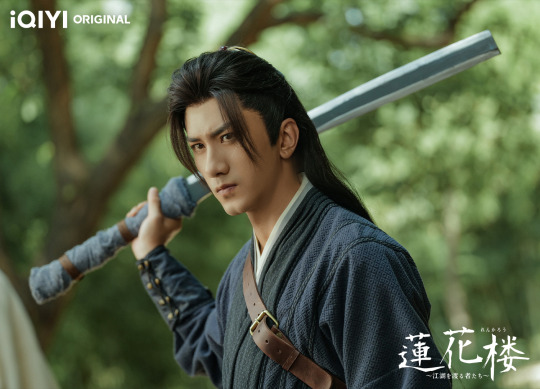


#mysterious lotus casebook#di feisheng#笛飞声#Di Feisheng's dao#which is just named 刀#刀就是刀要什麼名字#i know more 刀 forms than 劍 forms and this is what i do with the knowledge
35 notes
·
View notes
Text
So, it's kind of well known that the original Wild Arms had some real janky "translation" issues, most of which actually accounted for transliteration from Japanese phonetics back to various original languages, rather than true translations from Japanese. Not the least of these being almost the entire big boss line up of Zeikfried, Alhazad, Lady Harken(she was the one who was fine actually) and Belselk, being mishandled from "Siegfried," "Alhazred," and "Berserk." (don't worry we'll come back to some of those later)

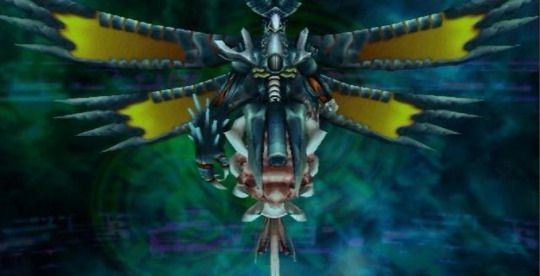
But one extra bit that gets sort of swept under the rug is Zeik Tuvai, Zeikfried's surprise final boss fight, where the mangled villain pries himself free from the amalgamation with the more conventional JRPG godmode "final" boss Motherfried to try and take the heroes out with him in a kind of suicide bombing run. (at least in the original where he's clearly been half absorbed and merged with his weapon, tearing his own body in half to escape, spinal cord still trailing behind him. Alter Code F seems to just be his own ascended dragon/angel form? Although he does appear to have taken Mother's heart with him when he escaped)
But that name, "Zeik Tuvai," also retained in the Alter Code F remake, is written in Japanese as, SHII-GU-TSU-VA-I[ジーグツヴァイ] which is very clearly meant to be the Japanese approximation of "Sieg Zwei." As in "Sieg(fried) Two."




But backing up a bit, his name, Siegfried is of course a reference to the Norse hero Prince Siegfried(aka Sigurd) of the Volsung saga, immortalized in various poetic, musical and theatrical works of the German and Scandinavian regions for centuries. Also just very well trafficked in Japanese pop culture as The German mythic hero of choice to reference.
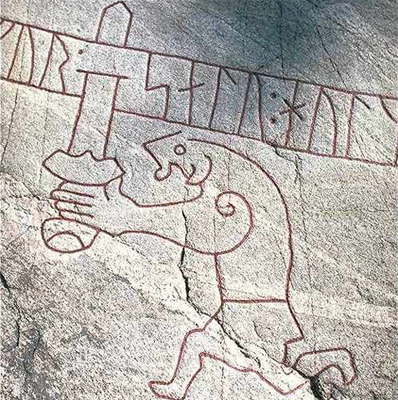


And while we're on the subject of Seigfried... His "sword," the Dark/Demon Spear, GRAM-ZANBER (GU-RA-MU-ZA-N'-BAA[グラムザンバー]) as officially romanized in Wild Arms 5's art design, and originally localized as "Glumzamber"(which for the longest time I just sort of assumed was a sloppy juggling of Gloom Saber back and forth between English and Japanese) appears to be a reference to the mythic Seigfried's legendary sword, Gram(aka Balmung) crossed with a contraction of the Japanese zanbato[斬馬刀]: lit."Horse Killing Sword" referring to a type of giant sword used specifically as an anti-cavalry weapon, appropriate for Gram-Zanber's size.
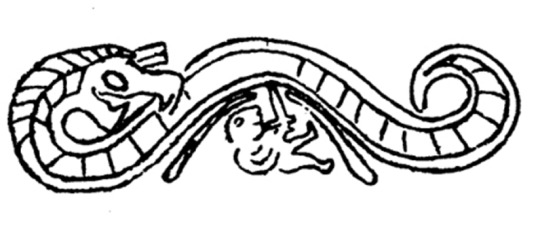
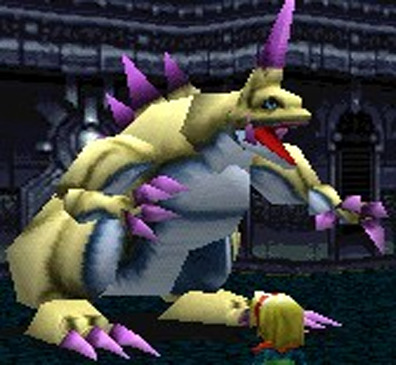
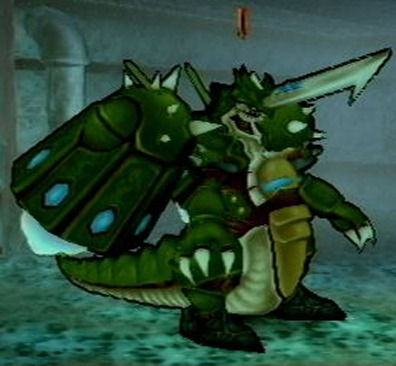

And the sword Gram is specifically featured as a highlight of Seigfried's slaying of the greed corrupted dwarf turned dragon, Fafnir. Fafnir is Which is of course the boss dragon in Wild Arms 3 that Seigfried merges with to become his final form, Dragnaseig. Incidentally some form of Fafnir has been present in nearly every Wild Arms game, but not always as plot relevant or even as a boss monster.
In the original Wild Arms a monster, mistranslated in English as "Fafneil," appears in the same final dungeon that leads to the ZeikTuvai fight, but as a regular random encounter and without any comment or explanation. It is also a recolor of existing Drake monsters elsewhere in the game. This design appears to have been the loose basis of the Wild Arms 3 redesign.(notably the Wild Arms 2 model looks entirely different from either)
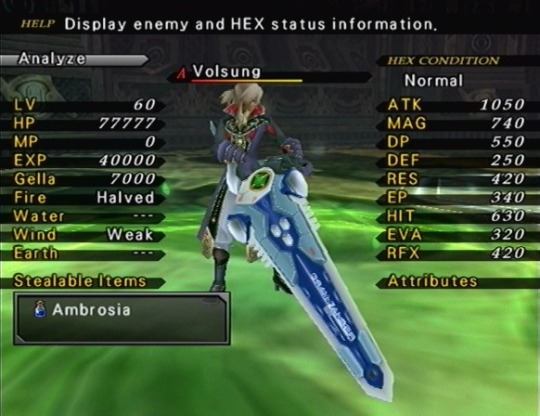

Oh and if it wasn't already clear the associations of Siegfried and the Volsung saga are why the villain Volsung, filling a hierarchical role similar to Siegfried's in Wild Arms 5, also wields his own conspicuously labeled version of the Gram-Zanber.
#wild arms#wild arms 3#wild arms 5#zeikfried#siegfried#i am immediately realizing my mistake in not taking the time to draft all these trivia blurbs before launching the first poll...#oops...
8 notes
·
View notes
Text
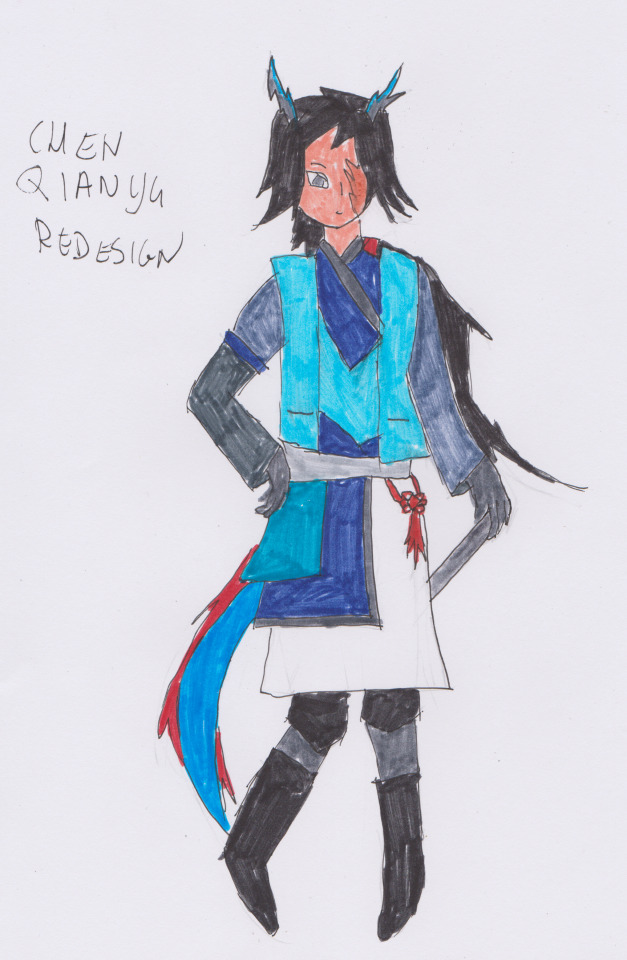
It's Chen Qianyu's turn! She sent me down the rabbit hole of Chinese martial arts.
And yes, Chinese, not Cantonese, according to her name being transliterated in Hanyu Pinyin. Other than that...frankly there wasn't much. Just the bog-standard 'she's really good in martial arts and she has learned everything there is yet she is also still a spirited youngster!' thing. Yet her sword was such a tiny detail (if it was on there at all) that I did look up some footage of her in motion, and I'm happy I did.
This girl dual-wields swords. Yep. I think they seemingly come out of one sheath? Anyway, it wasn't obvious so it isn't obvious here, but I did indeed dive into Chinese sword art a bit. Turns out, dual-wielding sword art is a thing in China, simply called shuangdao (双刀), literally 'double blade'. The shuangdao art I could find is actually part of tai chi, so it isn't meant to fight with. But the post I found contains a few videos of it, and I could easily see this being changed into an actual battle art if it were slightly edited. It looks so damn cool!
Despite that though, her actual battle motions I found to be the epitome of boring and cliche. Oh well. Chinese company can't bother to look into Chinese martial art, I see.
For her design...I think that someone who's so focused on martial arts would also be a slight bit of a fashion disaster. I made it so that this girl wears a vest over a dress, a long glove on one arm (which she also had before, but a smaller one on the other hand) and knee protectors. She also wears a Chinese knot on her hip to match with the red of the mane on her tail.
I changed her hair a tad bit. I liked how the front bangs are pointed outside like that, so I emphasized it. It's supposed to be reminiscent of a dragon's whiskers. Then, I reduced the amount of ponytails to one just to make her less of a Ch'en clone, and let it flow much like a dragon's body is.
From the start, I was planning to give her scars, so when I had hardship with the other eye I simply made her lack the other eye. Disability rep, amiright? I can imagine it'd be hard for her to relearn after losing depth vision.
I was also kind of iffy on the white dress, so I made it longer and removed the frills (honestly, those just kinda clashed with her description). Her full model view also showed that she has heels (of course...) making me substitute them for a pair of sturdy boots.
5 notes
·
View notes
Text
i wonder what Knives Chau's original chinese name is. i think that would be a sort of nice deep cut name to have. in the mandarin translation she's 小刀 or Xiao Dao which means "Little Knife" but I don't think thats her actual name just a translation of the nickname.
#looking it up her surname is the same as my partners surname#i suppose i also don't know for sure if she's named in mandarin or cantonese
3 notes
·
View notes
Text
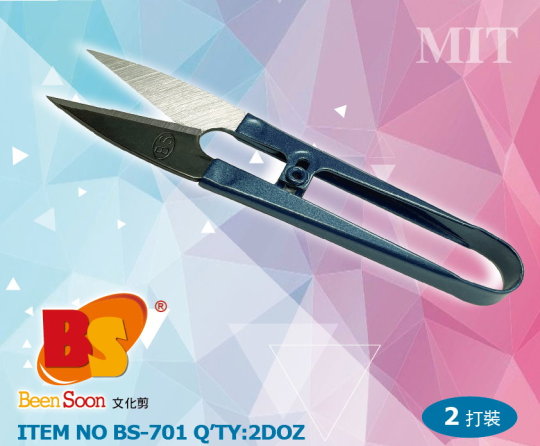
■紗剪刀Thread Clippers BBB
Product Name : Thread Clippers
Item Number:BS-701
Description:
Professional quality seamstresses/ tailors thread snips. These make light work of machine sewing and embroidery.
This item is extremely sharp. Use with caution. Hand and eye protection is recommended at all times
Good quality spring-actioned Thread Snips to remove all unwanted threads from your work.
After sewing up a storm, we are all left with several loose thread “tails” from changing colours or moving to a new line of sewing. With these spring-actioned Blue Thread Snips, you are able to effectively and quickly remove all unwanted threads from your work. Featuring an ultra-sharp tip, these snips are a valuable tool in any sewers arsenal.
A must-have tool for all sewers, embroiders, and quilters.
Color: Blue
Material: Alloy Steel
Brand:BS (original BBB)
Blade Material: Stainless Steel,Metal
Product Dimensions: 4.25"L (10.6 cm)x 0.98"W
Style: Classic
Item Weight: 0.6 Ounces (16gram)
Manufacturer: BEENSOON OF TAIWAN
Made in Taiwan.
Product Details
EASY TO USE: With small size, it is easy to carry. It can fit your palm well, get close to where you really want to cut, and clip it preciously without being stuck. When cutting, just press the handle, which is easy to open and close.
WIDE APPLICATION: It can be used in our daily manual works, such as sewing, cutting thread, embroidery, knitting, clipping plastic paper, office paper and other office supplies, cutting fishing line and other DIY projects.
SHARP AND DURABLE: It is extremely firm and sharp, as the blade is made of high-quality high-carbon stainless steel, while the handle is made of one-piece, elastic metal material, fixed by a metal ring in the middle. Thus it is not easy to break.
PRODUCT INFORMATION: Overall size: 4.25×0.98×0.59 inches, blade length: 1.49 inches, single weight: 0.6 ounces
IMPORTANT NOTES: To prevent it from rusting in transportation, we smear it with oil. You may think it looks a bit dirty. So after receiving it, you should wipe it clean with tissue before use. Besides, it is very sharp, so please make sure that they are away from pets and children.
The scissors are designed with a unique pinch design that allows them to operate like tweezers, making it easier to get to hard-to-reach places. While they don't come with a blade cover, they do come with a plastic sheath for storage and safety. Many customers have expressed their appreciation for the snips, claiming they are sharp and easy to use. One user claimed it was perfect for snipping off thread from freshly sewn garments, while another said it was great for cutting beading thread.
Measuring just 4.25' long, these thread snip scissors from the Beensoon are compact and easy to use. Their sharp pointed blades make them idea for beadwork and projects where you don't want to have to grab a traditional scissor. They cut a variety of cords and threads. Thread Snips 4.25 Inches Long,
We have confidence that you will be satisfied with our quality products, services and price. We look forward to your favourable reply and we hope that will be trust upon to kindly patronage our product. For more information please visit our website at http://www.beensoon.com.tw
■Thread Clippers BBB
(Scissors , Sewing Scissors, Yarn Scissors , Thread Snips, Thread Snippers, Blue Thread Clippers Metal, Sewing Scissors for Fabric, Thread Yarn Embroidery Clipppers Cutter, Small Snips Trimming Nipper, Great for Stitch, Art Craft, Mini DIY Supplies, Mini Sewing Scissors, Beading, Embroidery Multi-Purpose Small Thread Cutter, Suitable for Making Handicrafts, DIY Supplies )
https://www.beensoon.com.tw/
#How to Use Beensoon Thread Snips#Thread Clippers BBB#Scissors#Sewing Scissors#Yarn Scissors#Thread Snips#Thread Snippers#Blue Thread Clippers Metal#Thread Yarn Embroidery Clipppers Cutter#Small Snips Trimming Nipper#Great for Stitch#Art Craft#Mini DIY Supplies#Mini Sewing Scissors#Beading#Embroidery Multi-Purpose Small Thread Cutter#Suitable for Making Handicrafts#DIY Supplies
2 notes
·
View notes
Text
Names
I want to state right here that I love Japanese and can read/speak it more or less (I can't write it, because my handwriting is ugly and I lack practice), but ever since I came back with Yu-Gi-Oh ARC-V and I fell in love again of the characters and Connectshipping I realized that except for Yūya, Yuzu, Ruri and Ray who have a family, the rest of the dimensional counterparts do not have a last name. While in the Arc-V manga the Yu-boys share the last name Sakaki, in the anime they don't, so I took the liberty of giving them all last names. These last names were chosen because they were somehow related to them.
I'll do the Yu-boys part first, putting the only boy who has a last name in the anime canon:
Yūya Sakaki [榊 遊矢]
Yūya, being the protagonist, his name begins with the usual Yū (遊) that he shares with all his predecessors and successors, which means Play. The Ya (矢) that ends up composing his name means Arrow.
The surname Sakaki (榊) refers to the Cleyera japonica, an evergreen tree that is relevant in Shinto ceremonies, where it acts as a conduit for the kami (gods).
Now let's move on to the guys who don't have a last name in the anime canon:
Yūto [ユート]
I gave my beloved Yūto, my favorite and a dark boy with a taste for ghost knights, the last name Yatōgami (夜刀神) which is composed of Night (夜, Ya), Sword/Katana (刀, Tō) and God (神, Kami/Gami).
His name in the anime is written in katakana and therefore has no meaning, so I took the one from the manga that is in kanji. Yūto is composed with the Yū of Play (遊) and the To refers to the constellation Ursa Major (斗).
— Yūto Yatōgami (夜刀神 遊斗, Yatōgami Yūto).
Yūgo [ユーゴ]
Yūgo, precious child of sun and sky, also his name in the anime is written in katakana and without meaning, but taking the manga it is written with the Yū of Play (遊) and the Go of "Myself" (吾).
His last name, Hayashi, is written with Fast (速, Haya) and Ruler (司, Shi). Fits my boy with bike well.
— Yūgo Hayashi (速司 遊吾, Hayashi Yūgo).
Yūri [ユーリ]
Ah, Yūri, precious sadist of my soul, this baby, just like his counterparts, his name is written in katakana and has no meaning, so I once again took the name from the manga and gave it to this tradition-following beauty and begins with Yū of Play (遊) and ends with Ri of Town/Village (里).
The surname, Niwa, is a homophone that in Japanese means Garden, but is written with the kanji for Vermilion (丹, Ni) and Ring/Circle (輪, Wa).
— Yuri Niwa (丹輪 遊里, Niwa Yuri).
Zarc [ズァーク]
I personally like to take the name Zarc as a nickname or alias that this guy created for himself or was given to him by others when he got into dueling, and to my liking, I gave this guy a Japanese name.
Yūhaku is made up of Play (遊, Yū) and a kanji spelling Koma-Inu, the lion-dogs that guard Shinto shrines (狛, Haku). This name came up while I was looking for words that sounded similar to the Japanese pronunciation of Zarc "Zāku", and I really liked Haku, so I added the characteristic Yū and that's how my headcanon of what is the Supreme Dragon King's real name came up.
Speaking of dragon kings, the last name I came up with for Zarc was Kōryū, which is spelled with Emperor (皇, Kō) and Dragon (竜, Ryū). This one came up while he was looking for words to replace the long (and chūnibyō) Haōryū and since I didn't want Ōryū because it was redundant, I started looking at words related to ruling. Originally the name was written with the kanji for Five in front, but it got long and ugly, so I removed it and I loved how it turned out.
Also, in case I needed his name to be non-Japanese, I ended up using someone else's headcanon and stuck with "Zachary Archer", which can be made into "Z-Arc".
— Yūhaku Kōryū (皇竜 遊狛, Kōryū Yūhaku).
— Zachary Archer.
If I do a fanfic, it's 90% likely that I'll use these names, because I'm picky and I don't like that they don't have last names. I'll do the girls' one another time, since I really liked the last name I gave Rin, so I want to show it off. Anyway, I already did the long part, so I end here.
#yu gi oh#arc v#yugioh yuya#last names#naming#japanese kanji#headcanon#yu gi oh arc v#yugioh#sakaki yuya#yuto arc v#yuto yugioh#yugo arc v#yugo yugioh#yuri arc v#yuri yugioh#zarc arc v#zarc yugioh#yuya arc v
23 notes
·
View notes